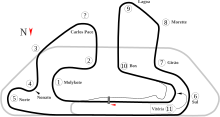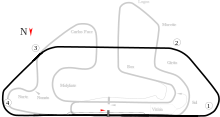Autódromo Internacional Nelson Piquet
Stock Car Brasil (1979–2012) Campeonato Brasiliero de GT (2008–2012) Stock Car Corrida do Milhão (2008) F3 Sudamericana (1989–1992, 1997, 1999–2000, 2002–2005, 2008–2009, 2011–2012) | |
| Short Circuit (1996–2012) | |
|---|---|
| Surface | Asphalt |
| Length | 3.336 km (2.073 miles) |
| Turns | 7 |
| Race lap record | 1:06.756 ( |
| Modified Grand Prix Circuit (1996–2005) | |
| Surface | Asphalt |
| Length | 4.933 km (3.065 miles) |
| Turns | 13 |
| Race lap record | 1:43.275 ( |
| Emerson Fittipaldi Speedway (1996–2005) | |
| Surface | Asphalt |
| Length | 3.000 km (1.864 miles) |
| Turns | 4 |
| Race lap record | 38.891 ( |
| Original Grand Prix Circuit (1978–1995) | |
| Surface | Asphalt |
| Length | 5.031 km (3.126 miles) |
| Turns | 11 |
| Race lap record | 1:32.507 ( |
The Autódromo Internacional Nelson Piquet (Nelson Piquet International RaceTrack), also known as Jacarepaguá after the neighbourhood in which it was located, and also as the Autódromo Riocentro, was a motorsport circuit in Rio de Janeiro, Brazil. Opened in January 1978, a few weeks before 1978 Brazilian Grand Prix, it hosted the Formula One Brazilian Grand Prix on ten occasions, and was also used for CART, motorcycle racing and stock car racing. In 2012, it was demolished to make way for facilities to be used at the 2016 Summer Olympics.
The original circuit
The original circuit was built between 1971 and 1977 on the site of the Barra da Tijuca road course, which had itself been built on reclaimed marshland and was operational from 1964 to 1970.[1] It was a relatively flat circuit, with a long pit straight and a longer back straight (which allowed the turbo-engined Formula One cars of the mid-1980s to reach speeds of 300 km/h (190 mph), and numerous mid-speed to slow-speed corners with plenty of room for overtaking. The maximum spectator capacity was 90,000. With the exception of the 1978 race, the Formula One Grand Prixs were held in March or April in Rio's very hot and humid tropical early autumn weather.
Formula One


The first Brazilian Grand Prix at the circuit took place shortly after opening, in 1978, and was won by Argentina's Carlos Reutemann in a Flat-12 Ferrari 312T3 in the oppressive heat and humidity of Rio's January summer season, after Sweden's Ronnie Peterson had taken pole position in the revolutionary ground-effect Lotus 78-Ford.
After the
The
Piquet and Rosberg again crossed the line first and second in the 1983 race, although this time only Rosberg was disqualified, having had a push start in the pits after his Williams FW08-Ford caught fire. Unusually, the drivers below Rosberg were not promoted accordingly. The win was the first of two wins at the circuit for Piquet, who would go on to win his second World Championship that year. Piquet won the race in his Brabham-BMW turbo and went on to be the first ever F1 World Champion to be powered by a turbocharged engine. From 1983 until 1989, the Brazilian Grand Prix was the opening race of the season.
Both the
After Piquet won his third (and final) World Championship in 1987, the circuit was named after him in 1988. However, he had to settle for third in a Lotus 100T-Honda in that year's race, as Prost once again won in a McLaren MP4/4-Honda. 1988 was the last year of the original turbo era in Formula One. For Prost it was his 5th win in 9 races at the circuit.
The 1989 race was the first to be held following the banning of turbo engines, and Great Britain's Nigel Mansell took a surprise win in his V12 powered Ferrari 640, complete with Formula 1's first semi-automatic gearbox. Another Brazilian driver, Maurício Gugelmin, finished third in a March 881 (Prost finished second), while Senna, who had won his first World Championship the year before, set the fastest ever lap of the circuit in qualifying with a time of 1:25.302 to take pole position in a V10 McLaren MP4/5-Honda. After winning the race, Mansell joked that with the Ferrari's known reliability problems at the time he had booked an early flight out of Rio in anticipation of a short race for him.
In 1990, the Brazilian Grand Prix moved to a shortened Interlagos, where it has been held ever since.
CART
From 1996 to 2000 the
The circuit qualifying record for the Emerson Fittipaldi Speedway was set by Emerson's own nephew Christian Fittipaldi with a time of 38.565 (280 km/h (170 mph)) for the 3.000 km (1.864 mi) track.
The long back straight of the road course which had grandstands running its entire 900 m (980 yd) length became the front straight of the Speedway, with the pits located in the area between the straight and the pit straight of the road course.
Motorcycle Grand Prix
The circuit also hosted the
races.The first Rio Motorcycle Grand Prix was won by
Honda won seven of the nine Rio Grands Prix held, with Yamaha winning two.
Lap records
The official fastest race lap records at the Autódromo Internacional Nelson Piquet (Jacarepaguá) are listed as:
Final years
As of early 2005, there were plans to partially demolish this racetrack to make room for a new sports complex to be used for the
Another proposal for the circuit was to have both a club permanent circuit, and an international-length half-permanent, half-car park circuit involving that circuit and an extension which utilises the car parks of the park. That would have been designed by Hermann Tilke.
In January 2008 it was announced that the track was to be demolished to allow the city to build an Olympic Training Centre venue for the Rio de Janeiro bid for the 2016 Summer Olympics which Rio was successful in winning.[14]
As of 2008, the 3.336 km (2.073 mi) track[15] comprised the original circuit's second half with a hairpin that connects the previous main straight and back straight. It remained active, with races such as Stock Car's Corrida do Milhão.[16]
The track and adjacent motorsport facilities were finally demolished in November 2012 to make way for new facilities to be used during the 2016 Summer Olympics.
In March 2013 Bernie Ecclestone, CEO of the Formula One Group, said discussions were taking place for the Formula 1 Grand Prix to move from the Interlagos Circuit in São Paulo to Rio de Janeiro and a suitable time for this could be 2016, coinciding with the 2016 Olympic Games. Formula 1 last raced at Rio in 1989 before returning to São Paulo in 1990, where it has been held since. However, no Grand Prix was held in Rio as of 2022.
See also
References
- ^ "Rio de Janeiro Track info". www.silhouet.com.
- ^ "2009 Rio do Janeiro Sud-Am F3". Retrieved 23 June 2022.
- ^ a b "Brasil GT Rio de Janeiro 2011". Retrieved 20 January 2023.
- ^ "Xandinho Negrão - Driver Database". Retrieved 20 January 2023.
- ^ "PORSCHE GT3 CUP CHALLENGE 2011 - 6ª Et GT3 Cup - GT3 CUP - PROVA 12 Car @ Jacarepaguá (Brazil) • 15 September 2011". Retrieved 17 July 2022.
- ^ "Brasil GT Rio de Janeiro 2012". Retrieved 20 January 2023.
- ^ a b "Alan Hellmeister - Driver Database". Retrieved 20 January 2023.
- ^ "2011 Stock Car Pro Series Rio de Janeiro". Retrieved 6 November 2022.
- ^ "2005 Rio do Janeiro Sud-Am F3 - Round 10". Retrieved 23 June 2022.
- ^ "2004 Brazilian Formula Renault Rounds 7&8: Rio de Janeiro, 22nd August Race 2". Retrieved 17 July 2022.
- ^ "2005 Brazilian Stock Car Championship Round 3: Rio de Janeiro, 19th June". Retrieved 16 July 2022.
- ^ "1999 Grande Premio do Rio de Janeiro (Race 2)". Retrieved 13 July 2022.
- ^ "1992 Rio do Janeiro Sud-Am F3". Retrieved 23 June 2022.
- ^ Jacarepagua to be demolished
- ^ F-3 sul-americana volta ao Rio depois de três anos Archived May 17, 2011, at the Wayback Machine – Tazio (in Portuguese)
- ^ Valdeno Brito ganha Corrida do Milhão no Rio Archived September 9, 2008, at the Wayback Machine – Tazio (in Portuguese)
External links
- Satellite picture by Google Maps
- Trackpedia guide to driving Autódromo Internacional Nelson Piquet
- Save the Rio de Janeiro International Raceway




